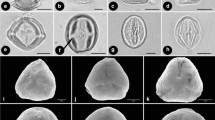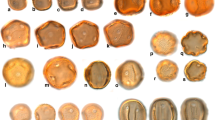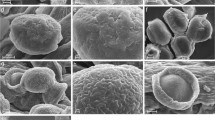Abstract
Oybak Dönmez E. 2008. Pollen morphology in Turkish Crataegus (Rosaceae). Bot. Helv. 118: 59 – 70.
Pollen morphology of 20 Turkish Crataegus L. taxa (Rosaceae) was studied using light and scanning electron microscopy to assess whether pollen traits are of taxonomic value in this species group. The most frequent aperture type was tricolporate, but non-tricolporate pollen grains (trisyncolporate, tetracolporate and inaperturate) were also present in many taxa, and pollen grains of varying aperture types were even found on the same plant. There was considerable variation within and between plants in pollen size (polar axis and equatorial axis ranging from 15 to 65 μm) and in aperture size, but no consistent differences between the taxa examined. Exine patterns varied from a striate-perforate type (the most common one) to rugulate, perforate and microreticulate types. Again, most taxa represented by several specimens in this study had variable patterns. These results imply that pollen traits cannot be used to distinguish Turkish Crataegus taxa or to draw conclusions about their taxonomic affinities.
Similar content being viewed by others
Author information
Authors and Affiliations
Corresponding author
Additional information
Manuscript accepted 15 April 2008
Electronic Supplementary material
Rights and permissions
About this article
Cite this article
Dönmez, E.O. Pollen morphology in Turkish Crataegus (Rosaceae). Bot. Helv. 118, 59–70 (2008). https://doi.org/10.1007/s00035-008-0823-5
Published:
Issue Date:
DOI: https://doi.org/10.1007/s00035-008-0823-5




